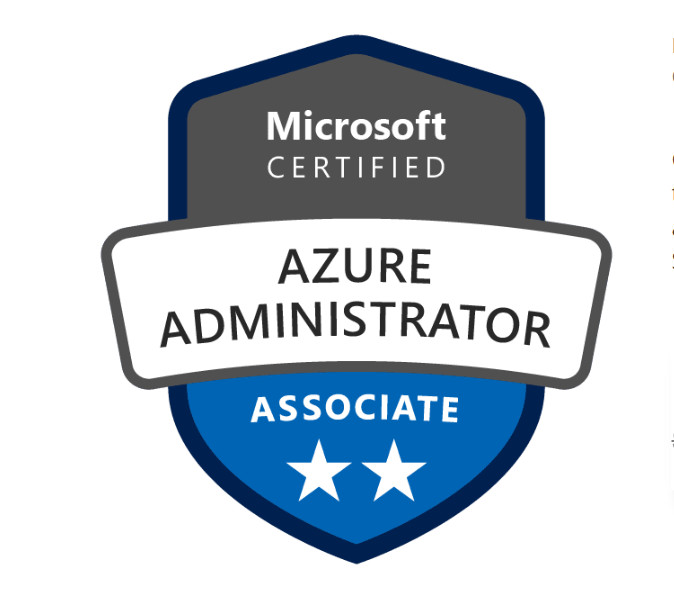Tin tức
HƯỚNG DẪN BÀI THI AZURE 104: MICROSOFT AZURE ADMINISTRATOR
HƯỚNG DẪN BÀI THI AZURE 104: MICROSOFT AZURE ADMINISTRATOR
22/07/2024 10:51

Chứng chỉ Microsoft Certified: Azure Administrator Associate (Azure 104): Thể hiện các kỹ năng chính để cấu hình, quản lý, bảo mật và quản trị các chức năng chuyên nghiệp quan trọng trong Microsoft Azure.
Đây cũng là chứng chỉ tiên quyết của một quản trị viên Azure.
- Mã bài thi: Azure 104
- Giá thi tại Việt Nam: 80usd
- Thời gian thi: 100 phút
- Số điểm thi đạt tối thiểu: 700 điểm
- Hình thức thi: Online hoặc Offline tại các trung tâm khảo thi của Pearson Vue
- Gia hạn chứng chỉ: Các chứng chỉ của Microsoft hết hạn hàng năm. Các thí sinh cần tham gia bài thi Online miễn phí trên Microsoft learn để gia hạn
- Tóm tắt các kỹ năng cần chuẩn bị cho bài thi:
1. Manage Azure identities and governance (20–25%)
- Manage Microsoft Entra users and groups
Create users and groups
Manage user and group properties
Manage licenses in Microsoft Entra ID
Manage external users
Configure self-service password reset (SSPR)
- Manage access to Azure resources
Manage built-in Azure roles
Assign roles at different scopes
Interpret access assignments
- Manage Azure subscriptions and governance
Implement and manage Azure Policy
Configure resource locks
Apply and manage tags on resources
Manage resource groups
Manage subscriptions
Manage costs by using alerts, budgets, and Azure Advisor
recommendations
Configure management groups
2. Implement and manage storage (15–20%)
- Configure access to storage
Configure Azure Storage firewalls and virtual networks
Create and use shared access signature (SAS) tokens
Configure stored access policies
Manage access keys
Configure identity-based access for Azure Files
- Configure and manage storage accounts
Create and configure storage accounts
Configure Azure Storage redundancy
Configure object replication
Configure storage account encryption
Manage data by using Azure Storage Explorer and AzCopy
- Configure Azure Files and Azure Blob Storage
Create and configure a file share in Azure Storage
Create and configure a container in Blob Storage
Configure storage tiers
Configure snapshots and soft delete for Azure Files
Configure blob lifecycle management
Configure blob versioning
3. Deploy and manage Azure compute resources (20–25%)
- Automate deployment of resources by using Azure Resource Manager (ARM) templates or Bicep files
Interpret an Azure Resource Manager template or a Bicep file
Modify an existing Azure Resource Manager template
Modify an existing Bicep file
Deploy resources by using an Azure Resource Manager template or a
Bicep file
Export a deployment as an Azure Resource Manager template or convert
an Azure Resource Manager template to a Bicep file
- Create and configure virtual machines
Create a virtual machine
Configure Azure Disk Encryption
Move a virtual machine to another resource group, subscription, or
region
Manage virtual machine sizes
Manage virtual machine disks
Deploy virtual machines to availability zones and availability sets
Deploy and configure an Azure Virtual Machine Scale Sets
- Provision and manage containers in the Azure portal
Create and manage an Azure container registry
Provision a container by using Azure Container Instances
Provision a container by using Azure Container Apps
Manage sizing and scaling for containers, including Azure Container
Instances and Azure Container Apps
- Create and configure Azure App Service
Provision an App Service plan
Configure scaling for an App Service plan
Create an App Service
Configure certificates and Transport Layer Security (TLS) for an App
Service
Map an existing custom DNS name to an App Service
Configure backup for an App Service
Configure networking settings for an App Service
Configure deployment slots for an App Service
4. Implement and manage virtual networking (15–20%)
- Configure and manage virtual networks in Azure
Create and configure virtual networks and subnets
Create and configure virtual network peering
Configure public IP addresses
Configure user-defined network routes
Troubleshoot network connectivity
- Configure secure access to virtual networks
Create and configure network security groups (NSGs) and application
security groups
Evaluate effective security rules in NSGs
Implement Azure Bastion
Configure service endpoints for Azure platform as a service (PaaS)
Configure private endpoints for Azure PaaS
- Configure name resolution and load balancing
Configure Azure DNS
Configure an internal or public load balancer
Troubleshoot load balancing
5. Monitor and maintain Azure resources (10–15%)
- Monitor resources in Azure
Interpret metrics in Azure Monitor
Configure log settings in Azure Monitor
Query and analyze logs in Azure Monitor
Set up alert rules, action groups, and alert processing rules in Azure
Monitor
Configure and interpret monitoring of virtual machines, storage
accounts, and networks by using Azure Monitor Insights
Use Azure Network Watcher and Connection Monitor
- Implement backup and recovery
Create a Recovery Services vault
Create an Azure Backup vault
Create and configure a backup policy
Perform backup and restore operations by using Azure Backup
Configure Azure Site Recovery for Azure resources
Perform a failover to a secondary region by using Site Recovery
Configure and interpret reports and alerts for backups
Để có kỹ năng làm việc thực tế cũng như kiến thức để vượt qua bài thi. Các thí sinh cần hoàn thành khóa học đào tạo trực tiếp với giảng viên có kinh nghiệm.
Tham gia khóa học tại BKACAD, học viên được cấp voucher giảm giá 45% lệ phí thi chứng chỉ quốc tế và hướng dẫn đăng ký thi trên Pearson VUE.
Tham khảo lộ trình học tập tại: Khóa học MCSA - AZURE
Đăng ký các chính sách hỗ trợ học phí của BKACAD tại: https://bkacad.edu.vn/dang-ky-hoc.html



